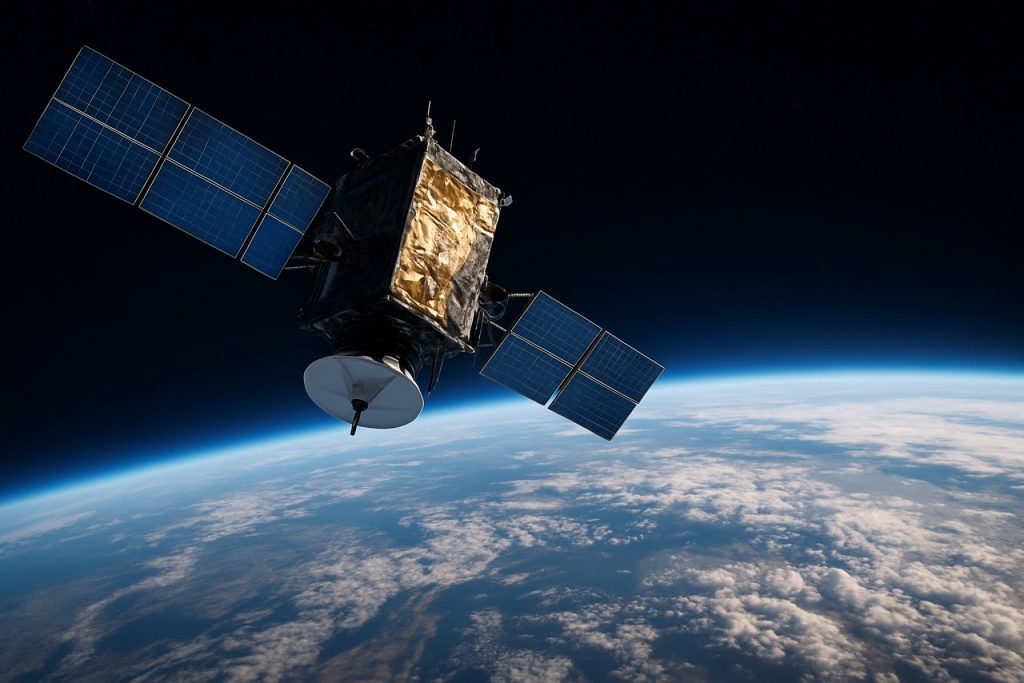
Satellite-Based Asset Tracking Industry Report 2025: Market Growth, Technology Innovations, and Strategic Insights for the Next 5 Years
- Executive Summary & Market Overview
- Key Technology Trends in Satellite-Based Asset Tracking
- Competitive Landscape and Leading Players
- Market Growth Forecasts (2025–2030): CAGR, Revenue, and Volume Analysis
- Regional Market Analysis: North America, Europe, APAC, and Rest of World
- Future Outlook: Emerging Applications and Investment Hotspots
- Challenges, Risks, and Strategic Opportunities
- Sources & References
Executive Summary & Market Overview
Satellite-based asset tracking refers to the use of satellite communication networks and positioning systems to monitor, manage, and optimize the movement and status of assets—such as vehicles, cargo, equipment, and personnel—across global geographies. Unlike terrestrial tracking solutions, satellite-based systems provide ubiquitous coverage, including remote and maritime regions where cellular or radio networks are unavailable. This capability is increasingly vital for industries such as logistics, oil & gas, mining, agriculture, and defense, which require real-time visibility and control over assets in challenging environments.
In 2025, the satellite-based asset tracking market is experiencing robust growth, driven by the expansion of global supply chains, heightened security requirements, and the proliferation of Internet of Things (IoT) applications. According to MarketsandMarkets, the global satellite IoT market—which underpins asset tracking—was valued at approximately USD 1.1 billion in 2023 and is projected to reach USD 2.9 billion by 2028, registering a CAGR of over 21%. This growth is fueled by increasing demand for end-to-end asset visibility, regulatory compliance, and the need to mitigate losses from theft, loss, or operational inefficiencies.
Key players such as Iridium Communications, ORBCOMM, and Inmarsat are expanding their service portfolios, leveraging advancements in low Earth orbit (LEO) satellite constellations and hybrid connectivity solutions. These innovations are reducing latency, lowering costs, and enabling higher data throughput, making satellite-based tracking more accessible to a broader range of enterprises and government agencies.
Regionally, North America and Europe remain the largest markets due to established logistics networks and early adoption of telematics. However, Asia-Pacific is emerging as a high-growth region, propelled by rapid industrialization, infrastructure development, and government initiatives to enhance supply chain transparency. Sectors such as maritime shipping, cross-border trucking, and remote resource extraction are particularly reliant on satellite-based solutions for uninterrupted asset monitoring.
Looking ahead, the integration of artificial intelligence, edge computing, and advanced analytics with satellite-based asset tracking platforms is expected to unlock new value propositions, including predictive maintenance, automated alerts, and optimized routing. As the cost of satellite connectivity continues to decline and device miniaturization advances, the market is poised for further expansion and innovation through 2025 and beyond.
Key Technology Trends in Satellite-Based Asset Tracking
Satellite-based asset tracking is undergoing rapid transformation in 2025, driven by technological advancements that are expanding its reach, accuracy, and cost-effectiveness. This technology leverages satellite networks to monitor and manage assets—ranging from shipping containers and vehicles to livestock and remote infrastructure—across global and remote locations where terrestrial networks are unavailable or unreliable.
One of the most significant trends is the proliferation of Low Earth Orbit (LEO) satellite constellations. Companies such as SpaceX (Starlink), OneWeb, and Iridium Communications are deploying thousands of LEO satellites, providing near-real-time global coverage and reducing latency compared to traditional geostationary satellites. This enables more frequent data transmission and supports applications requiring high update rates, such as fleet management and real-time cargo monitoring.
Another key trend is the integration of satellite connectivity with terrestrial IoT networks. Hybrid solutions are emerging, allowing seamless switching between cellular, LPWAN (Low Power Wide Area Network), and satellite links. This approach, championed by providers like ORBCOMM and Inmarsat, optimizes costs and ensures continuous coverage, especially for assets moving between urban and remote areas.
Advancements in device miniaturization and power efficiency are also shaping the market. Asset tracking devices are becoming smaller, lighter, and more energy-efficient, enabling longer deployment periods and easier installation on a wider range of assets. For example, Globalstar and Kinetix have introduced compact trackers with multi-year battery life, supporting long-term monitoring in harsh environments.
Artificial intelligence (AI) and advanced analytics are increasingly being integrated into satellite-based asset tracking platforms. These technologies enable predictive maintenance, anomaly detection, and route optimization, transforming raw location data into actionable insights. According to Gartner, the use of AI in asset tracking is expected to reduce operational costs and improve supply chain resilience in 2025.
Finally, regulatory developments and standardization efforts are facilitating interoperability and data security. Organizations such as the International Telecommunication Union (ITU) are working on global standards for satellite IoT communications, ensuring secure and reliable data exchange across borders and networks.
Competitive Landscape and Leading Players
The competitive landscape of the satellite-based asset tracking market in 2025 is characterized by a mix of established satellite operators, specialized tracking solution providers, and emerging technology firms. The sector is witnessing intensified competition as demand for real-time, global asset visibility grows across industries such as logistics, maritime, oil & gas, and agriculture. Key players are differentiating themselves through advancements in satellite constellations, integration of IoT technologies, and value-added analytics services.
Leading Players
- Iridium Communications Inc. remains a dominant force, leveraging its global LEO satellite network to provide reliable, low-latency asset tracking solutions. Its Iridium Edge and Iridium Certus platforms are widely adopted for fleet management and remote asset monitoring.
- ORBCOMM Inc. is another major player, offering end-to-end IoT and M2M connectivity. The company’s dual-mode (satellite and cellular) devices and cloud-based analytics platforms are favored by logistics and transportation firms seeking seamless coverage.
- Inmarsat Global Limited continues to expand its presence, particularly in maritime and aviation asset tracking. Its L-band satellite services and Fleet Xpress platform provide high-availability connectivity for mission-critical applications.
- Globalstar, Inc. offers cost-effective satellite asset tracking devices and services, targeting sectors such as agriculture, construction, and emergency response. Its SPOT and SmartOne product lines are recognized for their ease of deployment and reliability.
- European Space Agency (ESA) and other public sector entities are fostering innovation through partnerships and funding, supporting startups and SMEs in developing next-generation tracking solutions.
Emerging players, including Kepler Communications and Swarm Technologies (now part of SpaceX), are disrupting the market with nanosatellite constellations that promise lower costs and higher data throughput. These entrants are accelerating the democratization of satellite-based tracking, making it accessible to smaller enterprises and new use cases.
Strategic collaborations, mergers, and acquisitions are shaping the competitive dynamics. For example, Viasat Inc.’s acquisition of Inmarsat in 2023 has consolidated market share and expanded service portfolios. The competitive landscape in 2025 is thus defined by technological innovation, ecosystem partnerships, and a race to deliver scalable, cost-effective, and globally ubiquitous asset tracking solutions.
Market Growth Forecasts (2025–2030): CAGR, Revenue, and Volume Analysis
The satellite-based asset tracking market is poised for robust growth between 2025 and 2030, driven by increasing demand for real-time monitoring across logistics, transportation, maritime, and defense sectors. According to recent projections, the global market size is expected to reach approximately USD 12.5 billion by 2030, up from an estimated USD 6.8 billion in 2025, reflecting a compound annual growth rate (CAGR) of around 13.2% during the forecast period MarketsandMarkets.
Volume-wise, the number of satellite-enabled tracking devices deployed worldwide is anticipated to surpass 25 million units by 2030, compared to about 13 million units in 2025. This surge is attributed to the proliferation of low-cost, low-power satellite IoT modules and the expansion of satellite constellations, which are making global coverage more accessible and affordable Berg Insight.
Regionally, North America is projected to maintain its dominance, accounting for over 35% of total market revenue in 2025, fueled by strong adoption in fleet management and government applications. However, Asia-Pacific is expected to register the fastest CAGR, exceeding 15%, as logistics and supply chain modernization accelerates in emerging economies Fortune Business Insights.
- Key Growth Drivers (2025–2030):
- Expansion of global supply chains and cross-border trade, necessitating end-to-end asset visibility.
- Technological advancements in satellite communications, including LEO constellations and hybrid connectivity solutions.
- Regulatory mandates for tracking high-value and hazardous cargo in sectors such as oil & gas and pharmaceuticals.
- Revenue Breakdown by Application (2025):
- Transportation & Logistics: 48%
- Maritime: 22%
- Defense & Security: 15%
- Others (including agriculture, mining): 15%
Overall, the satellite-based asset tracking market in 2025 is set for double-digit growth, underpinned by technological innovation, expanding use cases, and the need for resilient, global asset monitoring solutions Gartner.
Regional Market Analysis: North America, Europe, APAC, and Rest of World
The satellite-based asset tracking market is experiencing robust growth across all major regions—North America, Europe, Asia-Pacific (APAC), and the Rest of the World (RoW)—driven by increasing demand for real-time visibility, regulatory compliance, and the expansion of global supply chains.
North America remains the largest market, underpinned by the presence of leading technology providers, advanced logistics infrastructure, and high adoption rates in sectors such as transportation, oil & gas, and defense. The United States, in particular, is a key driver, with government initiatives supporting the integration of satellite IoT for fleet management and critical asset monitoring. According to Grand View Research, North America accounted for over 35% of the global market share in 2024, a trend expected to continue into 2025 as companies prioritize supply chain resilience and security.
Europe is witnessing significant growth, propelled by stringent regulatory frameworks around cargo security and environmental monitoring. The European Union’s focus on digital transformation and sustainability is encouraging the adoption of satellite-based solutions in logistics, agriculture, and maritime sectors. Countries such as Germany, France, and the UK are leading the charge, with investments in both public and private satellite constellations. The European Space Agency’s support for commercial satellite ventures further accelerates market maturity in the region, as noted by MarketsandMarkets.
- APAC is the fastest-growing region, with a projected CAGR exceeding 15% through 2025. Rapid industrialization, expanding e-commerce, and government-backed smart infrastructure projects in China, India, and Southeast Asia are fueling demand. The region’s vast geography and challenging terrains make satellite-based tracking indispensable for cross-border logistics and remote asset management, as highlighted by Fortune Business Insights.
- Rest of the World (RoW)—including Latin America, the Middle East, and Africa—shows growing adoption, particularly in mining, oil & gas, and humanitarian logistics. While market penetration is lower compared to other regions, increasing investments in satellite infrastructure and the need for reliable tracking in remote areas are expected to drive steady growth through 2025.
Overall, regional dynamics in 2025 reflect a convergence of technological advancement, regulatory impetus, and industry-specific needs, positioning satellite-based asset tracking as a critical enabler of global operational efficiency and security.
Future Outlook: Emerging Applications and Investment Hotspots
Satellite-based asset tracking is poised for significant evolution in 2025, driven by advances in satellite constellations, miniaturized tracking devices, and the integration of artificial intelligence (AI) for data analytics. As global supply chains become more complex and the demand for real-time visibility intensifies, satellite-enabled solutions are expanding beyond traditional logistics to encompass new sectors and geographies.
Emerging applications are particularly notable in remote and underserved regions where terrestrial networks are unreliable or nonexistent. In 2025, industries such as mining, oil & gas, and agriculture are expected to increase adoption of satellite-based asset tracking to monitor equipment, vehicles, and livestock across vast, inaccessible areas. The maritime sector is also a key growth area, with enhanced vessel tracking and cargo monitoring solutions leveraging low-Earth orbit (LEO) satellite networks for improved coverage and latency (Iridium Communications Inc.).
Another promising application is in humanitarian logistics and disaster response. Satellite asset tracking enables real-time monitoring of relief shipments and critical infrastructure, supporting rapid deployment and resource allocation in crisis zones. Additionally, the integration of Internet of Things (IoT) sensors with satellite connectivity is opening new possibilities for environmental monitoring, such as tracking endangered wildlife or monitoring deforestation in remote forests (Inmarsat).
From an investment perspective, 2025 is expected to see heightened activity in both established and emerging markets. Venture capital and private equity are increasingly targeting startups developing ultra-low-cost tracking devices and data analytics platforms tailored for satellite networks. Strategic partnerships between satellite operators and logistics technology firms are accelerating, as seen in recent collaborations between satellite providers and global supply chain integrators (Spire Global).
- Asia-Pacific is emerging as a hotspot, driven by rapid industrialization and government initiatives to digitize logistics and infrastructure.
- Latin America and Africa are attracting investment due to the need for connectivity in remote regions, particularly for agriculture and resource extraction.
- Europe and North America continue to lead in R&D and regulatory frameworks, fostering innovation and cross-border asset tracking solutions.
Overall, the future outlook for satellite-based asset tracking in 2025 is characterized by diversification of applications, technological convergence, and robust investment flows, positioning the sector for sustained growth and transformative impact across industries.
Challenges, Risks, and Strategic Opportunities
Satellite-based asset tracking is poised for significant growth in 2025, driven by the increasing need for real-time visibility of assets across remote and global supply chains. However, the sector faces a complex landscape of challenges and risks, alongside strategic opportunities that could reshape its trajectory.
Challenges and Risks
- High Initial Costs: Deploying satellite-based tracking solutions involves substantial upfront investments in hardware, satellite bandwidth, and integration with existing IT systems. This can be a barrier for small and medium-sized enterprises (GSMA).
- Regulatory Hurdles: Varying international regulations regarding spectrum allocation, data privacy, and cross-border data flows can complicate deployments, especially for global logistics providers (International Telecommunication Union).
- Latency and Bandwidth Constraints: While Low Earth Orbit (LEO) satellites have reduced latency, bandwidth limitations persist, particularly in high-density asset environments, potentially impacting data granularity and real-time responsiveness (McKinsey & Company).
- Cybersecurity Threats: As asset tracking systems become more interconnected, they are increasingly vulnerable to cyberattacks targeting data integrity, location spoofing, and unauthorized access (European Union Agency for Cybersecurity).
Strategic Opportunities
- Expansion into Underserved Regions: Satellite-based solutions can bridge connectivity gaps in remote or infrastructure-poor areas, unlocking new markets in Africa, Latin America, and parts of Asia (European Space Agency).
- Integration with IoT and AI: Combining satellite tracking with IoT sensors and AI-driven analytics can deliver predictive maintenance, route optimization, and enhanced supply chain transparency (Gartner).
- Emergence of New Business Models: The rise of “tracking-as-a-service” and pay-per-use models lowers entry barriers and enables flexible scaling for customers (Satellite Today).
- Partnerships and Ecosystem Development: Collaborations between satellite operators, logistics firms, and technology providers can accelerate innovation and standardization, addressing interoperability and regulatory challenges (Inmarsat).
In 2025, the satellite-based asset tracking market will be shaped by how industry players navigate these risks and capitalize on emerging opportunities, with success hinging on technological innovation, regulatory agility, and ecosystem collaboration.
Sources & References
- MarketsandMarkets
- Iridium Communications
- ORBCOMM
- Kinetix
- International Telecommunication Union (ITU)
- European Space Agency (ESA)
- Swarm Technologies
- Berg Insight
- Fortune Business Insights
- Grand View Research
- McKinsey & Company
- European Union Agency for Cybersecurity
- Satellite Today



